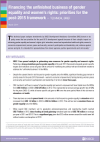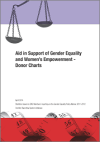FOUND 9 RESULTS
Paper discussing the definition and measurement of Sustainable Development Goal (SDG) Indicator 5.c.1 (reclassified to Tier II) and discussing the relationship of SDG Indicator 5.c.1 with other Indicators.
This note provides an overview of existing gender equality markers and reviews issues relating to the tracking and monitoring of investments related to gender equality and women’s empowerment. It is intended as an input into the development of a guidance note for the UN system on principles and standards for the design, implementation and reporting systems on investments that support gender equality and women’s empowerment in the UN system.
This technical paper analyses investments by OECD Development Assistance Committee (DAC) donors in six policy areas that are priorities for the...
This toolkit follows the transfer of public funds from central to local governments until they reach users such as schools and clinics. It explains how a public expenditure tracking system operates and how it can benefit marginalized groups. With this toolkit local communities can track the inputs, outputs, and outcomes of particular government services, and determine the gender-specific distribution of benefits from those services.
The guidance note sets out commom principles and standards for gender equality markers systems that track and report on allocations and expenditures for gender equality and women's empowerment.
This publication is a compilation of two studies carried out to assess GRB in the peacebuilding and Health programmes under the EC/UN Women...
The Global Programme ‘Increasing Accountability in Financing for Gender Equality’ was developed to increase financing for national gender equality commit¬ments in sixteen countries and to strengthen government and donor accountability on financing decisions and practices. Drawing on diverse country experiences, this brief showcases the programme’s comprehensive ap¬proach together with its achievements and lessons. It also provides policymakers and gender advocates with...
The ITC/ILO gender marker is a one-digit code (on a 0 to 3 scale) used by ITC to assess ;whether or not ITC/ILO ;training activities are designed in a gender-sensitive way in order to address the needs of women and men as ultimate beneficiaries of development actions.The application of the marker is preceded by appropriate awareness-raising sessions and accompanied by guidance from gender specialists (if needed). This coding system is grounded in the gender accountability work done by...
The third report in a new research series on resources for women's rights organizing from the Association for Women's Rights in Development, this...




